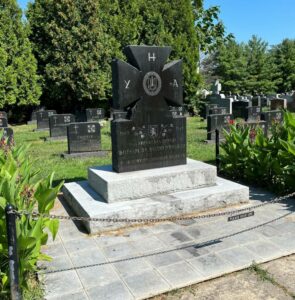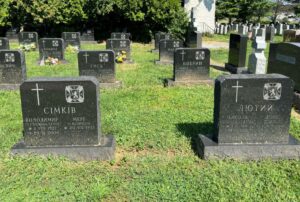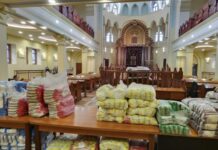
The Saint Mary’s Ukrainian Cemetery sits at 438 Cedar Road in Elkins Park. Like at most area cemeteries, you can drive in on a narrow road, park your car on the pavement or a patch of grass and walk up to almost any stone.
But there is one monument near the back, to the left and standing in front of trees that has a “Please Keep Off” sign dangling from the chain surrounding it. And that stone commemorates Ukrainian soldiers who fought with the Nazi Schutzstaffel (SS) during World War II.
The Jewish Federation of Greater Philadelphia, the ADL’s Philadelphia office and the American Jewish Committee Philadelphia/Southern NJ were among those calling for its removal.
And the Ukrainian Catholic Archeparchy of Philadelphia is listening: It met with the AJC on Sept. 8 and announced on Sept. 12 that it would temporarily cover the monument.
“Both parties acknowledged concerns about the monument and agreed that we need unity, support of each other and to have an ‘open, scholarly and compassionate dialogue.’ To this end, the AJC was invited to and plans to attend such a dialogue, which the Ukrainian Catholic Archeparchy proposed in its statement of September 8. Both parties also understand that the Archeparchy will temporarily cover the monument, per a statement that it is publishing on its social media and on its website,” according to a statement from both organizations.
“Both communities agreed that the bridge that was built is strong enough to bear the weight of any issue and will not divide us. We reiterate: no genocide should be forgotten; no genocide should be allowed. Never again. We sincerely hope that the friendship and support that the Jewish and Ukrainian peoples have established since Ukraine regained its independence will only flourish and be stronger,” the statement continued.
The Ukrainian Catholic Archeparchy is the association for the Ukrainian Greek Catholic Church in the eastern United States. The Cathedral of the Immaculate Conception, based in Philadelphia, is a member of the archeparchy and the owner of the cemetery site.
Taking down the monument is important for two reasons, according to Jason Holtzman, the director of the Jewish Community Relations Council within the Jewish Federation.
“No. 1, it will be one less Nazi memorial in the world,” Holtzman said. “No. 2, it will show that the archeparchy doesn’t stand with this SS unit.”
“1943-1945,” the stone reads in the middle. “In Memory of Ukrainian Soldiers,” it says at the bottom. In between the years is a shield with a lion and crowns inside. It’s the symbol for the Ukrainian unit, SS Galichina, in the SS. It’s also a sign of hate, according to the Anti-Defamation League. The same symbol is engraved into the stones of many veterans of the unit who are buried behind the memorial.

The monument was erected in 1993, according to Moss Robeson, who reports on Ukrainian nationalist groups. It stood unnoticed until Robeson tweeted a picture of a Ukrainian far-right leader posing alongside it in May. Then in August, The Forward added the stone to its global list of Nazi monuments. In September, The Philadelphia Inquirer spread the story to a local audience.
Veterans’ groups built the stone to “celebrate the 50th anniversary of the creation of the unit,” according to the Inquirer article. They did not need approval or supervision from the archeparchy, according to an association spokeswoman. “Volunteers and conscripts from Nazi-occupied Ukraine” were part of the unit. Many came from a region called Galicia, now part of modern-day Poland and western Ukraine.
Since the soldiers decided to fight Adolf Hitler’s war against the Soviet Union, some saw Nazi collaboration “as a means toward establishing an independent Ukrainian state.” And after the war, “8,000 soldiers from the division were allowed to emigrate.” Many ended up in Philadelphia.
The argument that these soldiers were freedom fighters does not stand, according to Holtzman and Andrew Goretsky, the regional director of ADL Philadelphia.
“It was an SS unit,” Holtzman said.
“Any monument dedicated to a Nazi or Nazi-adjacent group needs to be removed and replaced,” Goretsky added.






